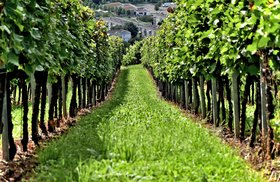Sangiovese Wine: Styles, Best Wines, Prices (2025)
Considering getting a Sangiovese wine for your next dinner party?
Sangiovese, pronounced “san-jo-vay-zay,” is Italy’s much-loved, most-planted red grape variety. It’s the core ingredient in some of the best Italian wines, including Brunello di Montalcino and Chianti.
Where does Sangiovese grow? What does it taste like? What foods do Sangiovese wines pair well with?
Explore all about this earthy Italian wine before you buy one. Find out where it’s grown, winemaking techniques, food pairings, and 8 exceptional Sangiovese wines to add to your fine wine collection.
Further reading
- Check out this ultimate Red Wine guide to discover all about red wines and buy some of the most coveted ones!
- Or, explore the fascinating world of White Wines in this detailed article!
All About Sangiovese Grapes and Wine
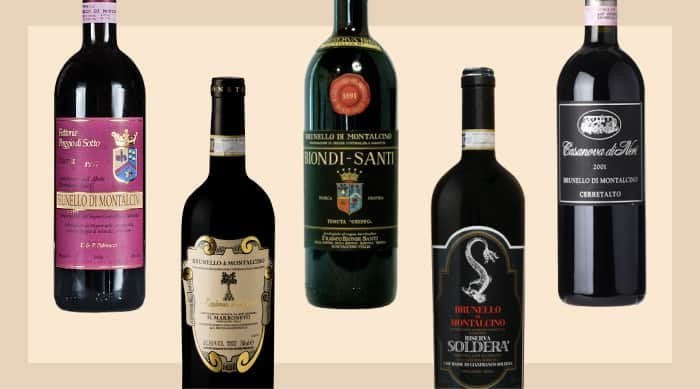
Sangiovese (sometimes called Sangioveto) is a dark-berried vine and is the most planted grape variety in central Italy (Tuscany). Although this Italian grape has a dark purplish-blue color, it produces a bright cherry red wine.
Interestingly, it’s name comes from Latin for ‘blood of Jupiter’ or ‘blood of Jove.’
Sangiovese is a hardy grape, but it does require a skilled viticulturist to get the best out of it. As for Sangiovese wine, it’s a terroir driven one, just like Pinot Noir. (More about the viticulture of Sangiovese in a bit.)
There are hundreds of different Sangiovese clones that are being grown in central and southern Italy. Sangiovese Grosso (used for Brunello di Montalcino) and Sangiovese Piccolo (grown in Chianti) are the two most important families.
Let’s take a quick look at the history of Sangiovese.
A Brief History Of Sangiovese
The earliest mention of a Sangiovese based wine can be traced back to the time of Roman winemaking. It was also believed that the Sangiovese grape was cultivated in Tuscany by the Etruscans during the 6th century.
In the beginning, finding a bottle with Sangiovese on the label was extremely common. Sangiovese di Romagna was considered a cheap Italian wine and had a pale, light complexion and a bitter taste. It offered nothing a wine lover would want in a bottle of red wine. Luckily, today Sangiovese di Romagna succeeds all expectations in Emilia Romagna.
It was not until the 18th century that Sangiovese started to gain popularity for the right reasons. In 1883, Giovanni Cosimo Villifranchi, an Italian writer, described Sangiovese as “excellent when blended with other grape varieties.”
Bettino Ricasoli, an Italian winemaker, blended 70% Sangiovese with a 15% Canaiolo and 15% Malvasia Bianca, and the first recipe for Chianti was created.
Sangiovese didn’t enjoy the best reputation in the early-mid 1900s.
However, in the 1960s, Piero Antinori took over his family’s Marchesi Antinori estate in Tuscany. He initiated modern oak treatments and blends with other grape varieties like Cabernet Sauvignon and Merlot to create Super Tuscans like Tignanello.
It was only after this dramatic overhaul of the winemaking process that Sangiovese regained its popularity as the trendy wine of today!
Where Does Sangiovese Come From?

Sangiovese is the main grape used to produce red wines in Tuscany. There are other Old World and New World wine regions that have successfully produced fabulous Sangiovese wines.
Here are the main Sangiovese wine regions:
A. Italy
- Chianti DOCG: Chianti is the largest Sangiovese wine region - it covers one-third of Tuscany. Chianti wine must always have at least 70% Sangiovese. The wine styles are typically fresh with a medium body or oak-aged and dense.
2. Chianti Classico DOCG: Even though it is a sub-region, Chianti Classico is a DOCG appellation on its own. Chianti Classico must also have at least 80% Sangiovese grapes in its wine.
The main Sangiovese wines from the Chianti Classico DOCG - Chianti Classico Riserva and Chianti Riserva spend two years in oak and at least three months in a bottle during the aging process.
In 2016, the Chianti Classico Consorzio debuted the Gran Selezione. Sangiovese wines with Gran Selezione on the label must be produced solely from grapes grown on the estate. These wines must also be at least 90%, which minimizes the compromising impact of another grape varietal.
3. Montalcino: In a region that lies south of Siena (especially on the hills that surround Montalcino), you’ll find vineyards that produce high quality, full bodied Sangiovese wines. The two principal appellations of Montalcino are Brunello di Montalcino DOCG and Rosso di Montalcino DOC.
4. Vino Nobile Di Montepulciano DOCG: The Sangiovese grapes used to make Vino Nobile di Montepulciano must be grown on the hills that surround Montepulciano. The wines from this area must include at least 70% of the local Sangiovese clone, known as Prugnolo Gentile.
5. Carmignano and Montalbano DOCGs: Carmignano and Montalbano are adjacent wine regions west of Florence. Wines from Carmignano and Chianti Montalbano are Sangiovese based. They’re at least 50% Sangiovese, and are blended with 10-20% Cabernet Sauvignon and Cabernet Franc.
6. Morellino Di Scansano DOCG: Close to the Tyrrhenian coastline, southwest of Montalcino, is Morellino di Sansano. Here Sangiovese is known as “Morellino,” which directly translates as “little dark one.” Morellino has a complex taste with rich fruit flavors.
B. Other Countries
Although Sangiovese thrives in its homeland of Tuscany, there are other wine regions that successfully cultivate this red grape.
They are:
- The French island of Corsica (Sangiovese has been grown here since the 14th century and is known as Nielluccio)
- Napa, Sonoma County, Santa Barbara, Oregon, and the Sierra Foothills in the United States
- Argentina
- Australia
- Chile
Want to explore other stellar red wines from these wine regions? Check out these super-informative articles:
- 10 Best Red Wine Brands You Shouldn’t Miss in 2024
- Best Spanish Red Wines to Buy in 2024
- The Ultimate Guide to French Red Wine
Viticulture of Sangiovese Grapes

Sangiovese vines are adaptable to most soils, but it thrives in soils with a high concentration of limestone. It is the limestone that helps winemakers produce elegant wines with fabulous aromas.
In the Chianti Classico region, Sangiovese wine grapes thrive on dry, soft clay soil known as galestro. Meanwhile, in the Montalcino region, there is a large proportion of limestone based alberese and galestro.
Sangiovese grapes need a long growing season to develop richness and body. The grape buds early but takes time to fully ripen.
As Sangiovese is prone to overproduction, viticulturists need to keep an eye on the Sangiovese vine. Overgrown vines tend to produce wines that are light in color, with a high acidity level and lower alcohol levels.
Sangiovese Winemaking Techniques
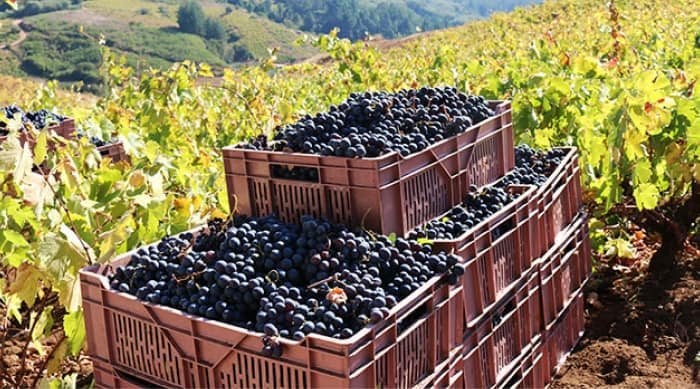
The pale color and high acidity of the Sangiovese grape varietal can pose challenges for winemakers. To balance this, some winemakers blend it with Cabernet Sauvignon to add some color and fruit to the wine.
Modern winemakers have tried numerous techniques to add some extra body and texture to Sangiovese. Whether it is using grapes from a low yielding vine to adjusting the length of fermentation and extensive oak treatment.
Another technique winemakers use to improve Sangiovese is to extend the maceration period. By increasing it from 7-12 days to 3-4 weeks, there is more time for the phenols to come out of the grape skins.
In the oak barrels, polymerization happens during the malolactic fermentation process, and it contributes to a softer, rounder mouthfeel. Modern producers prefer to use French oak barrels so that Sangiovese will soak up the vanilla and other oak compounds. More traditional winemakers still use chestnut barrels to age the wine.
Sangiovese Wine Characteristics
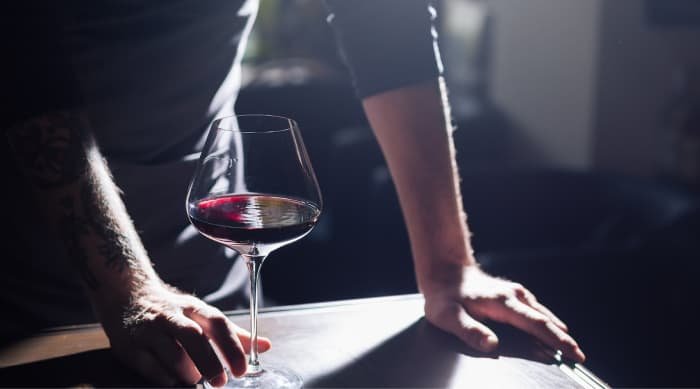
Sangiovese wines are tannic wines, with a balanced nature and high acidity.
What flavor profile should you expect from this red wine?
Sangiovese is a dry wine with a light to medium body, mouth watering acidity, and tight tannins.
You will find savory flavors of black stone fruit and dark cherries in a good bottle of Sangiovese wine. These flavors may have secondary notes of tomato leaf, spices, sour cherry, and dried herbs. With oak becoming more popular, it teases rich flavors of plum and wild raspberry out of the grape.
The high levels of acid in Sangiovese wine means that it will display many red fruit characteristics, with notes of black tea, chocolate, or tobacco.
Flavors of Sangiovese are also dependent on how and where the vines are grown.
Food Pairings and Serving Suggestions

Sangiovese has savory characteristics and a medium body, which makes it perfectly versatile for food pairings.
Classically it has been paired with Italian pizza, pasta, and anything that involves tomatoes (specifically tomato sauce). Other great picks to pair with Sangiovese are roasted meat, lamb chops, hard cheeses, and grilled steak.
Serve Sangiovese in a red wine glass at room temperature or with a slight chill. Slightly chilling the wine will help tame the tannins and let the florals and fruit come out.
Key Sangiovese Producers And Buying Tips
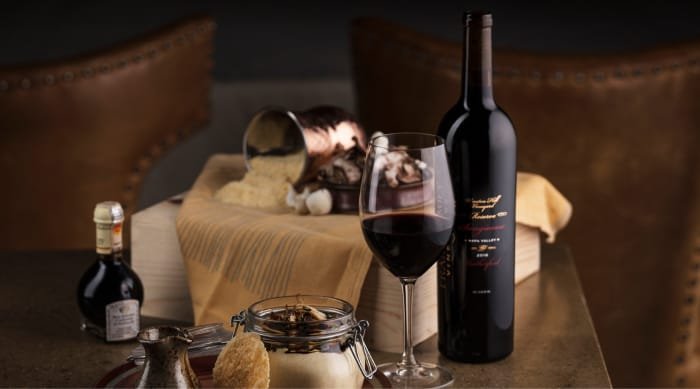
While shopping for a bottle of Sangiovese wine, pay attention to the label. Although Sangiovese is the grape name, it will have the “place name” on the bottle.
An easy way to find a great Sangiovese is to select wines with Chianti, Brunello di Montalcino and Super Tuscan on the label. Although these wines might be pricey, they will be worth it.
These producers and vineyards are known to consistently produce amazing Sangiovese wine:
- Altesino
- Antinori Pèppoli
- Casanova di Neri
- Castello di Ama
- Fattoi
- Fontodi
- Gianni Brunelli
- Ruffino
- Seghesio
- Umbria
Take a look at the 8 bottles we found for you.
Best Sangiovese Wines You Can Buy In 2024
1. 1983 Case Basse di Gianfranco Soldera Brunello di Montalcino Riserva DOCG, Tuscany, Italy

Case Basse di Gianfranco Soldera, also known as Case Basse or Soldera, was founded by Gianfranco Soldera in 1972 in the Montalcino region.
This dark red Sangiovese wine has notes of red cherry fruit with a slightly earthy aroma. Experience young fruit-forward flavors as your sip on this old vintage.
Price of a 1983 Case Basse di Gianfranco Soldera Brunello di Montalcino Riserva DOCG: $1823
2. 1988 Case Basse di Gianfranco Soldera Toscana IGT - Brunello di Montalcino DOCG, Tuscany, Italy

This 1988 medium bodied Tuscan wine has aromas of dark fruit, chocolate, and tobacco.
This red wine will take your palate on an exciting adventure. It starts with flavors of tea, prunes, fruit, and charcoal, and the taste will develop and change in your glass.
Price of a 1988 Case Basse di Gianfranco Soldera Toscana IGT: $1107
3. 1891 Biondi Santi Tenuta Greppo Riserva, Brunello di Montalcino DOCG, Italy
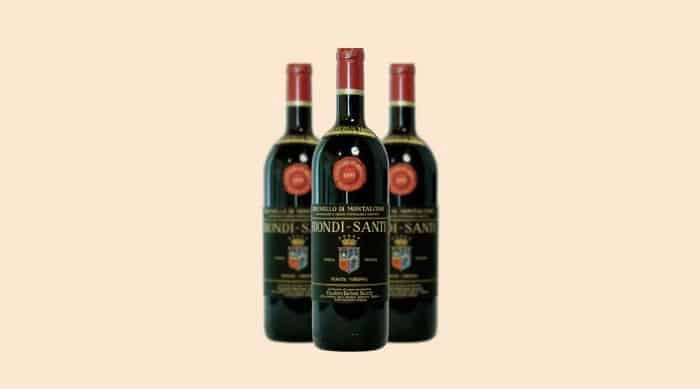
Produced by the inventor of Brunello di Montalcino, Ferrucio Biondi Santi, this 1891 vintage is the dream of every wine enthusiast.
This wine presents a ruby rose color and was aged for four years in Slavonian oak casks. It has an intense bouquet with notes of treacle flavored pipe tobacco.
Price of a 1891 Biondi Santi Tenuta Greppo Riserva: $24,214
4. 1997 Avignonesi Occhio di Pernice Vin Santo di Montepulciano, Tuscany, Italy

Produced by the Avignonesi winery in Southern Tuscany, in the region of Montepulciano, this red wine will meet every expectation of a red wine lover.
Although the thickness of this dessert wine resembles concentrated maple syrup, your palate will enjoy its extraordinary sweetness. This Sangiovese wine has gorgeous notes of brown sugar, roasted chestnuts, sweet figs, and prunes.
Price of a 1997 Avignonesi Occhio di Pernice Vin Santo di Montepulciano: $629
5. 1995 Fattoria Poggio di Sotto Brunello di Montalcino Riserva DOCG, Tuscany, Italy
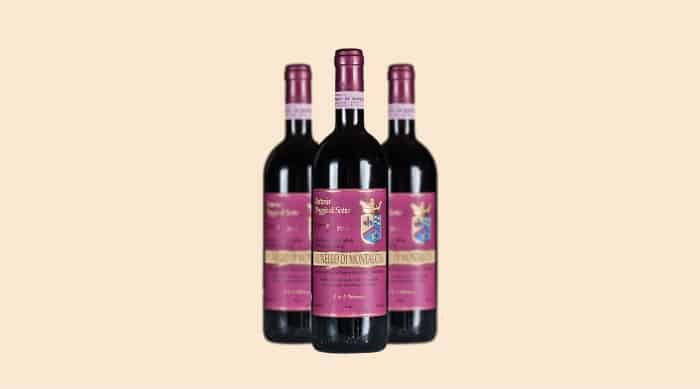
Founded in 1989, Poggio di Sotto is famous for its Brunello di Montalcino wines.
This 1995 vintage has a Ruby red color with garnet shadows. It has an intense bouquet, with a spicy and delicate background.
Price of a 1995 Fattoria Poggio di Sotto: $429
6. 2001 Casanova di Neri Cerretalto, Brunello di Montalcino DOCG, Italy
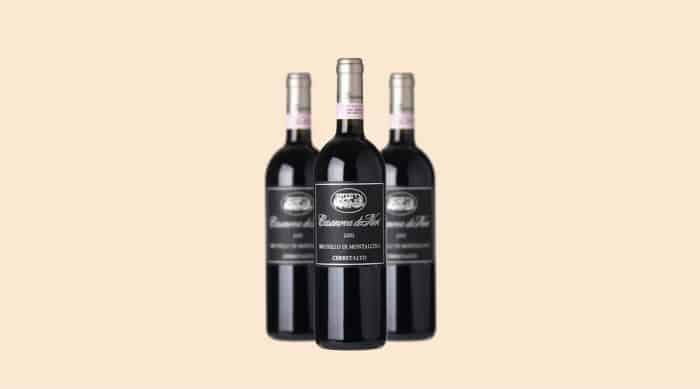
The 2001 Cerretalto is one of the most sought-after by collectors and connoisseur.
This full-bodied red wine has aromas of chocolate, coffee, crushed berries, light raisin, and treacle tart.
Price of a 2001 Casanova di Neri Cerretalto: $349
7. 2015 Poggio San Polo 'Vigna Vecchia', Brunello di Montalcino DOCG, Italy
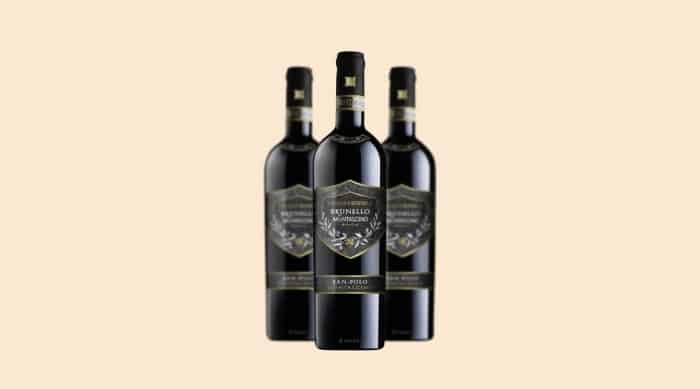
The 2015 Poggio San Polo is a red wine with superb depth and intensity. This wine has aromas of camphor, tobacco and underbrush.
On the palate, this full bodied wine features black cherry jam, roasted coffee bean, licorice, and toasted notes, which complements the velvety tannins.
Price of a 2015 Poggio San Polo 'Vigna Vecchia': $275
8. 2010 Il Marroneto Madonna delle Grazie, Brunello di Montalcino DOCG, Italy

This wine has vibrant crimson highlights which shine through its ruby red color. It has firm tannins, and it can age well in your cellar for at least 20 years.
It has notes of berries, pressed violets, wet earth, white truffle, licorice, herbs, and other aromas that take you to Tuscany.
Price of a 2010 Il Marroneto Madonna delle Grazie: $469
Time to discover the best way to buy red wine, Sangiovese wine or any other bottle from around the world?
Buy And Store Your Wines Perfectly Through Vinovest

Vinovest is a world-class online wine investment company that will help you invest in fine wines from around the world. This online investment platform will not only help you buy, but also authenticate, store, and sell your Syrah or Sangiovese wines, as well as other red and white wines.
Vinovest will also deliver your bottle of Sangiovese to your home if you want to open it or directly to the buyer if you choose to sell it.
How It Works
You can start investing in wine with Vinovest in four easy steps:
- Sign up
- Answer a brief questionnaire on your investment preferences and risk appetite.
- Add a minimum of $1,000 to your account.
- Track your fine wine portfolio online and watch it grow!
Benefits Of Investing In Wine Through Vinovest
Here are eight unique features of Vinovest.
- Best Prices and a Global Network
Vinovest buys wines from global wine exchanges, winemakers, and merchants at wholesale prices. This means you can get a bottle of Sangiovese from Chianti or Sonoma in California with just a click.
2. Provenance and Authenticity
Vinovest takes the guesswork out of buying wine. You will no longer worry about a wine’s origin or if it is authentic. Vinovest does all the background checks for you.
3. Stress-Free Buying, Selling, and Delivery
With just a few clicks, you could be buying, selling, and delivering wines with Vinovest’s AI-driven technology.
4. High-Performing Portfolio
Vinovest’s expert sommeliers will use a proprietary financial model to help you build your high-performing wine investment portfolio.
5. Optimal Storage
Your Sangiovese wine and other bottles need to be stored in the best conditions to help it age well. Vinovest keeps your wine in climate-controlled bonded warehouses that are close to some of the best wine regions in the world.
6. Insurance Coverage And Security
When you use Vinovest for all your wine investment needs, every bottle bought or sold is covered under insurance for breakage or loss. Your wines are also under 24/7 surveillance in the bonded warehouses.
7. Ownership
Even though Vinovest helps you buy, sell, or deliver your wine, every bottle in your portfolio is 100% yours. That's right - every bottle of Sangiovese and Merlot is yours!
8. Low Overall Costs
Vinovest charges a 2.5% annual fee (1.9% for a portfolio above $50,000). This fee covers
authentication, storage, insurance, management of your portfolio, buying, and selling your wine.
Experience the Charm of Tuscan Wine!
Buying an Italian wine like Sangiovese will help you experience the romance of Tuscany without having to go to Italy.
Sangiovese is the perfect red to pair with your roast chicken or to store in your cellar for a special occasion!
Build the best wine collection without having to leave your home by signing up on Vinovest’s world-class platform right away!

